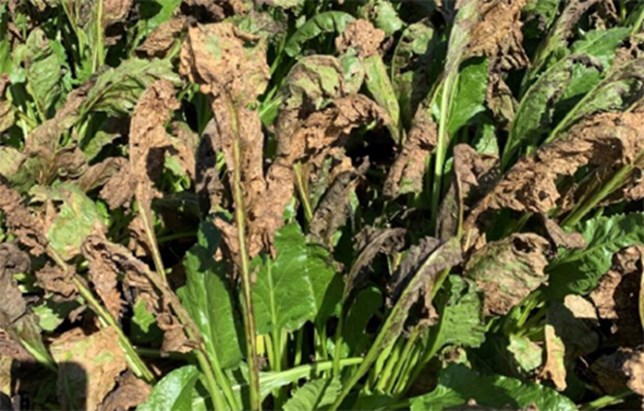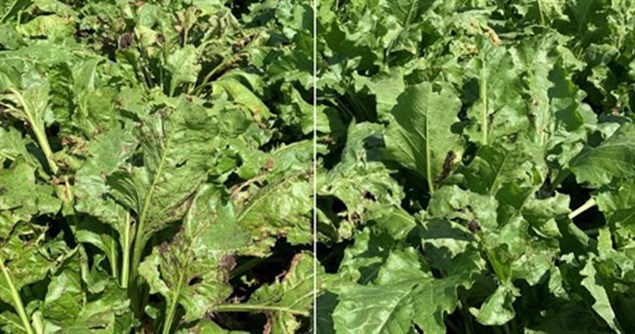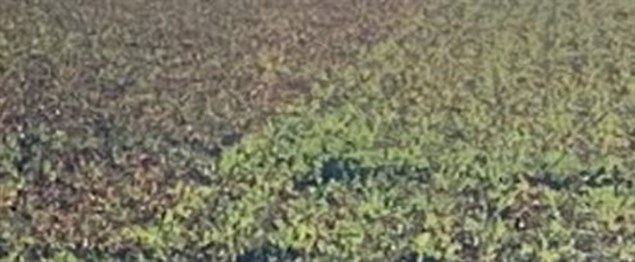614 - 2020 Cercospora Review
Cercospora Infections
Environment:
Weather conditions were extremely favorable for Cercospora Leaf Spot (CLS) infections this growing season and pressure/infections at this level probably haven’t been seen in over 20 years. It should be stated that these same environmental conditions are also favorable for sugarbeet development. That is why it is extremely important to protect the sugarbeet leaf with appropriate fungicide applications to keep it healthy to take maximum advantage of potential growth in yield and quality. Both are reduced when Cercospora Leaf Spot infection is at moderate to high levels which don’t allow the leaf to perform optimally to generate energy for the sugarbeet plant.

There were several “Two Shirt Days” this year with high temperatures and humidity. An intense, early period (end of June – first week of July) of high Daily Infection Values (DIV’s) hit the RRV from south to north. Throughout July and the beginning of August, moderate to severe DIV’s days occurred back-to-back almost every week. Bookending this growing season was another long stretch of 11 days in areas of moderate to severe DIV’s
from mid to late August. We have not experienced extended stretches on both the early and late side of the growing season for some time.
Cercospora is polycyclic in its reproduction, meaning it keeps self-propagating within the field and infecting the leaves. Once it’s established it just keeps rolling. Therefore, fungicides need to be used as a prevention and not a cure.
Practices that aided Cercospora management:
Set the table for success: A timely start is needed to not let Cercospora get established in a field. If you think you’re starting your fungicide spray program too early, you’re probably right on time. Once you’re behind you can’t catch up on Cercospora control. After infection, it takes 5-21 days for spots to appear. If a string of high DIV’s occur early, it’s best to be proactive as fungicides are only protectants and need to be used for managing Cercospora infection. It’s important to note that:
Delaying the start of a fungicide program is not the place to try to “save a spray”.
The image below shows a field split with different start dates of the Cercospora fungicide program.
- Left shows fungicide program starting July 7.
- Right shows fungicide program starting June 29.
- Even this early, the earlier start benefited control.

• Staying on track with proper 12-day fungicide application intervals. With the intense DIV’s continuing throughout this growing season it was critical to stay on time. Weather conditions change and are difficult to predict. Having fungicides in place to protect the sugarbeet leaf when favorable conditions occur is essential for control.
- Even when staying on proper fungicide spray intervals, loss of efficacy of the application can happen due to the washing off of contact fungicides (Tin, EBDC’s, copper).
- There were extreme, wind driven rain events this summer that may have washed off contact fungicides. Depending on how current the application was prior to the rain event, it negatively affected Cercospora control performance.
- ACSC Cercospora fungicide recommendations pair a contact fungicide (on leaf surface) with a translaminar or systemic fungicide (in leaf tissue). If the contact fungicide tank-mix partner washes off, you’re fighting with one hand (fungicide) tied behind your back for Cercospora control and resistance management.
- A follow up application may be necessary depending on how current the application was prior to the rain event.
• Tank-mixing and rotating fungicide modes of action throughout the fungicide program. This is important with fungicide resistance present at some degree for most of our available fungicides and to use full rates when doing so. With limited fungicide combination options to pair and rotate, ACSC tank-mix recommendations pair a stronger fungicide with one that may be weaker. What one fungicide doesn’t control, then the other tank-mix partner should. This also helps in keeping fungicides viable into the future. Use the fungicide resistance maps to help select products from the DMI/Triazole family for fungicide combinations to optimize control. Contact your Agriculturist who can help with this.
• Varietal Cercospora tolerance ratings. This year differences were noted in Cercospora incidence between varieties differing by just 0.5 in their CLS tolerance rating, say a 4.7 to a 4.2 rating. Many years this may not be noticed but this year due to the favorable environment it was. Better CLS ratings should improve Cercospora control but may not equate to fewer fungicide applications.
The image below shows a portion of a field that was not treated with fungicides and defines how CLS varietal tolerance ratings matter.
- Strip on the left is a variety with a 4.6 CLS rating
- Strip on the right is a variety with a 4.1 CLS rating (still has plenty of Cercospora but to a much lesser degree)

• Proper coverage, gallons/acre, and sprayer calibration.
- Streaks of Cercospora were observed in fields as well.
- Using 15-20 gallons of water/acre is necessary in order to obtain proper coverage of the leaf to protect it. Just as necessary is proper nozzle selection and calibration to apply a consistent volume of product across the spray boom. It is important that aerial applications use as much water/acre as possible for coverage,5 gal/acre should be the goal.
The image below shows Cercospora streaking

• Even when following all of these practices, Cercospora Leaf Spot occurred in fields at levels that were higher than ideal with the favorable environment. In those fields, Cercospora would have been much worse if those practices weren’t followed.
